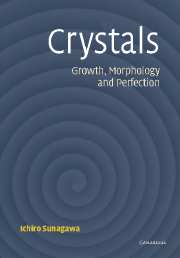Book contents
- Frontmatter
- Contents
- Foreword to the English translation
- Preface
- Part I Fundamental concepts
- Part II Application to complicated and complex systems (case studies)
- 9 Diamond
- 10 Rock-crystal (quartz)
- 11 Pyrite and calcite
- 12 Minerals formed by vapor growth
- 13 Crystals formed by metasomatism and metamorphism
- 14 Crystals formed through biological activity
- Appendixes
- Materials index
- Subject index
9 - Diamond
from Part II - Application to complicated and complex systems (case studies)
Published online by Cambridge University Press: 31 October 2009
- Frontmatter
- Contents
- Foreword to the English translation
- Preface
- Part I Fundamental concepts
- Part II Application to complicated and complex systems (case studies)
- 9 Diamond
- 10 Rock-crystal (quartz)
- 11 Pyrite and calcite
- 12 Minerals formed by vapor growth
- 13 Crystals formed by metasomatism and metamorphism
- 14 Crystals formed through biological activity
- Appendixes
- Materials index
- Subject index
Summary
There is no mineral, other than diamond, consisting of only sp3 covalent bonds which fits perfectly the purpose of this book. Diamonds are formed deep in the Earth under high-temperature and high-pressure conditions, and are uplifted during geological events to the Earth's surface at a speed of 100km/h. The history of natural diamond crystals, ranging from subduction of plates, growth of crystals in the upper mantle, plastic deformation associated with rapid uplifting, and partial dissolution experienced in the ascent process, is recorded within the crystal. Diamond crystals synthesized under high-temperature, high-pressure conditions, but from the solution phase with a different solvent component from that in natural crystallization, and those synthesized from the vapor phase under labile conditions, show different morphological characteristics, to the extent that a distinction between natural and synthetic diamonds can easily be made.
Structure, properties, and use
Diamond C is the high-pressure phase of carbon, and the C-C bonding is of sp3 pure covalent nature. The structure has a three-dimensional framework as indicated in Fig. 9.1, and is different from the low-pressure phase, graphite, which has a sheet structure consisting of sp2 covalent bonds and Van der Waals bonds connecting the sheets. Other polymorphs called lonsdalite, fullerene, and carbon nanotube, which consist of mixed sp2 and sp3 bonds, are also known.
In diamond C, it is the fact that the structure consists of sp3 covalent bonds only that accounts for its unique physical properties, such as the highest hardness of any material (Mohs hardness 10), small compressibility (1.7×10−7cm2/kg), the highest elasticity among any known material (46×1012 dynes/cm2, bulk elasticity), large thermal conductivity (9∼26 W/(deg cm)), and small thermal expansion coefficient (0.8±0.1×10−6 at 20°C, comparable to the value of invar).
- Type
- Chapter
- Information
- CrystalsGrowth, Morphology, & Perfection, pp. 167 - 197Publisher: Cambridge University PressPrint publication year: 2005
- 1
- Cited by



